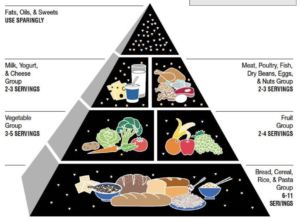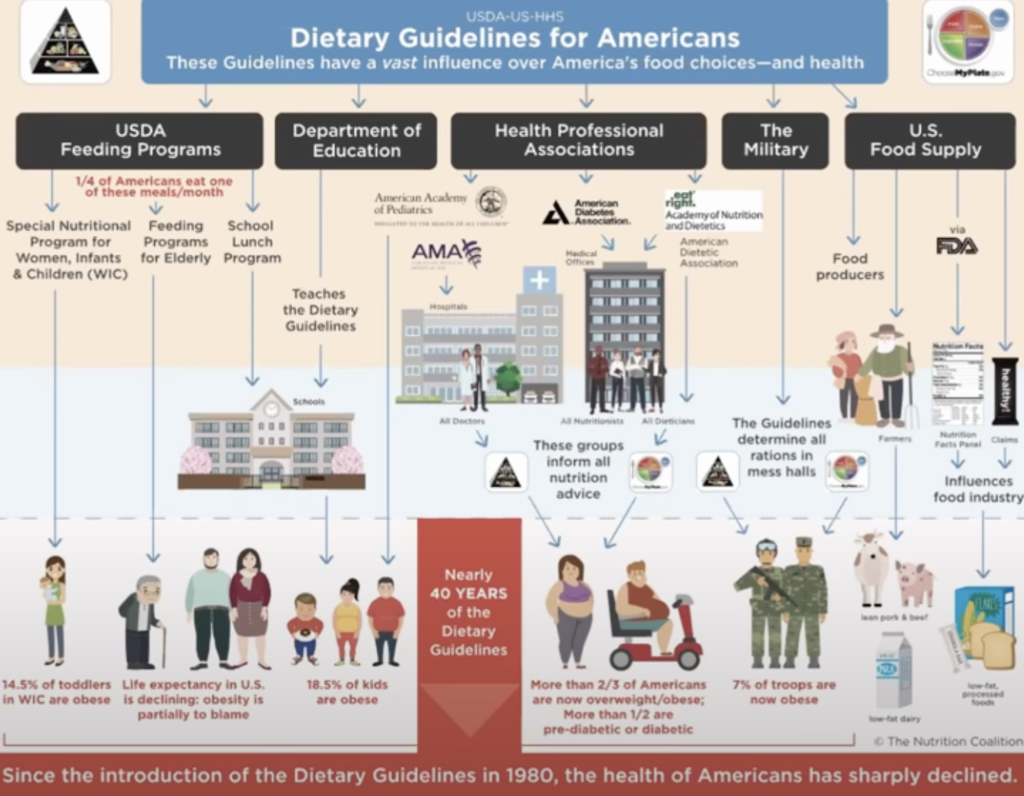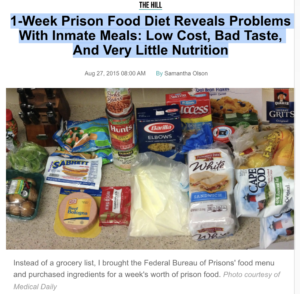Time to Reform Unhealthy Federal Prison Food
Update: See Food Behind Bars Podcast episode “The Science” for discussion of prison nutrition research. High sugar, high-carb foods a key problem in prisons. Interviews Kimberly Wilson about her podcast series Crime and Nourishment. Both reference: Influence of supplementary vitamins, minerals and essential fatty acids on the antisocial behaviour of young adult prisoners. Randomised, placebo-controlled trial (Br. J. Psychiatry, July 2002). Study found providing a vitamin, mineral, fatty acid supplement pill (vs. placebo pill) reduced prison violence by 25%.
A big mixup decades ago led nutrition researchers and the food industry down a dangerous path. Federal officials were misled by faulty research on the sources of escalating cardiovascular disease and the epidemic of heart attacks peaking in the 1960s:
Heart disease was an uncommon cause of death in the US at the beginning of the 20th century. By mid-century it had become the commonest cause. After peaking in the mid-1960s, the number of heart disease deaths began a marked decline that has persisted to the present.
The epidemic of the 20(th) century: coronary heart disease (NIH National Library of Medicine, September, 2014)
Influential researchers believed: “This increase was associated with an increase in smoking and dietary changes leading to an increase in serum cholesterol levels.”
So the push was on to reduce both smoking and cholesterol in the American diet. Initial studies implicated meat, eggs, and whole fat dairy, all with saturated fat, and cooking in saturated animal fats like lard and beef tallow (think McDonalds french fries). So a national public health campaign was launched promoting a low-fat Food Pyramid. The food industry was instructed to roll out hundreds of low-fat foods. But replacing fat usually meant adding sugar, processed carbohydrates, and industrial seed oils (PUFAs).
Unfortunately for tens of millions of Americans, saturated fat was caught in the crossfire between tobacco and sugar interests looking to shift blame from their products. How the Sugar Industry Shifted Blame to Fat (New York Times, September 12, 2016):
The sugar industry paid scientists in the 1960s to play down the link between sugar and heart disease and promote saturated fat as the culprit instead, newly released historical documents show.
The internal sugar industry documents, recently discovered by a researcher at the University of California, San Francisco, and published Monday in JAMA Internal Medicine, suggest that five decades of research into the role of nutrition and heart disease, including many of today’s dietary recommendations, may have been largely shaped by the sugar industry.
How the Sugar Industry Shifted Blame to Fat (New York Times, September 12, 2016)
These dietary changes influence prison food as well, which was made to conform to federal dietary guidelines. More on that below…
Decades of studies and articles on possible links between cancer and processed meats, as well as to environmental toxins were funded by the sugar and tobacco industries. Women’s magazines ran story after story about newly discovered carcinogens in foods and our environment, and in between these stories were ads with attractive people smoking. Portrayal of tobacco smoking in popular women’s magazines: a content analysis (Journal of Public Health, September 2017) reports:
Although tobacco advertising is prohibited in Britain, women’s magazines still appear to be promoting positive messages about tobacco and smoking…
In 146 magazines, there were 310 instances of tobacco content, the majority of which were positive towards smoking. Instances of celebrities smoking were most common (171, 55%), often in holiday or party settings that could be perceived to be luxurious, glamorous or fun. In all, 55 (18%) tobacco references related to fashion, which generally created an impression of smoking as a norm within the industry; and 34 (11%) text and image references to tobacco in TV and film. There were 50 (16%) reader-initiated mentions of smoking, typically in real-life stories or readers writing in to seek advice about smoking. Anti-smoking references including the hazards of smoking were infrequent (49; 16%).
Portrayal of tobacco smoking in popular women’s magazines: a content analysis (Journal of Public Health, September 2017)
Congress banned broadcast advertising for cigarettes, and the tobacco industry quickly shifted to print advertising, increasing spending by “by 49 and then 131 percent in constant dollars.” Magazines adjusted their editorial policies accordingly:
From an 11-year period preceding the ban to an 11-year period following it, these magazines decreased their coverage of smoking and health by 65 percent…
The cigarette advertising broadcast ban and magazine coverage of smoking and health (NIH National Library of Medicine, Spring, 1989)
Women’s magazines continued to run stories on health, but blame shifted from smoking to chemicals causing cancer and saturated fat (rather than sugar) causing heart attacks. Many stories highlighted the claimed science of the new federal dietary guidelines repeating recommendations for low-fat foods including whole grains and other carbohydrates. By running stories from environmental reporters and organizations highlighting possible new carcinogens in the environment, less attention was paid to smoking as the main cause of increased cancer rates. (And research showing sugar as a cause of cancer was more deeply buried.)
Cigarette advertising Philip Morris: How Virginia Slims Targeted Women to Sell Cigarettes (Medium, October 24, 2018).
Congressional action and Federal Nutrition Standards were born, along with a public relations campaign promoting a carbohydrate-heavy Food Pyramid.

Harvard’s School of Public Health has a A visual history of food guides (Fall, 2013) which includes: “1992 – The Food Guide Pyramid is the USDA’s first set of guidelines to include recommended servings for each of the food groups.“
The USDA’s Food Pyramid was taught in public schools and guided government-funded meals in schools, hospitals, nursing homes, prisons, and the military, plus medical advice provided through Medicare and Medicaid. One in four American meals still followed updated versions of the Food Pyramid (now called the Food Plate).
Unfortunately for hundreds of millions of Americans, Europeans, and others, the Food Pyramid was based on a theory that turned out to be wrong. Americans have gained weight and body fat in large part because they are being served less nutrient dense foods, lots of carbohydrates, processed foods designed to taste okay with less fat, and polyunsaturated oils (PUFAs, criticized as “industrial seed oils”).
Its a long story and still unfolding, with blame falling on public health officials, the processed food industry, university nutrition departments (often funded by the food industry), plus now vegetarian and vegan interests and enthusiasts and the legacy (low-fat) established diet industry (The weight loss and weight management diet market size was valued at 192.2 billion in 2019.)
Healthier nutrition for federal prisoners (and prison guards?)
For debaters with the NCFCA prison reform resolution waiting for how all this applies to their prison reform topic: Poor nutrition contributes to heart disease and other chronic conditions among federal prisoners, and also contributed to high suicide rates and violence in prisons. Lack of safety in prison also adds stress and further disturbs metabolic health.
Baylen Linnekin’s Reason article America’s Prison Food Is Still Criminally Awful: And COVID-19 has made it worse (Reason, December 12, 2020), reports:
This week, Impact Justice, a nonprofit that advocates for criminal justice reform, released a report on the state of foods served to prison inmates across the United States. The first-ever national report on prison food, Eating Behind Bars: Ending the Hidden Punishment of Food in Prison, shines a critical light on “the quality and consequences” of food served in America’s prisons.
Also, Crime and nourishment – the link between food and offending behaviour (The Conversation, September 28, 2018) notes:
Alarmingly, research suggests over half of food items available for purchase in some prisons in the UK and the US are “high in fat or sugar”. It has also been suggested that in the US, prison food has been described as “scant, joyless, and unsavoury”. But it doesn’t have to be like this. … Poor nutrition can impact on concentration and learning and may result in episodes of violent or aggressive behaviour. In prison, a bad diet can also contribute to increased rates of poor mental and physical health compared with the general population.
Food for thought: Prison food is a public health problem (Prison Policy Initiative, March 3, 2017) looks at poor nutrition in Washington state prisons.
Nutrition for Inmates (Eating Right PRO, October 1, 2015) reviews the claims of the guy in charge: “CDR Mitchel Holliday, MS, MSEd, RDN, CDE, FAND, BOP’s chief dietitian and commissioned officer within the United States Public Health Service.” However, federal prisons are misled (just like public schools, hospitals, military, veterans, Medicare and Medicaid) by the politicized federal nutritional guidelines:
“Since its implementation, we have reduced cholesterol and saturated fat levels to those recommended by the Dietary Guidelines for Americans and sodium offering by one-third,” he says. “We have also been able to develop a number of standardized medical nutrition related clinical practice guidelines for such areas as diabetes management, food allergies and post-bariatric surgery management.”
But this leads into another politicized debate between the benefits and health impacts of plant-based vs. animal-based diets.
What Do You Eat in Prison? (in Prison Survival Guide, Zoukis Consulting Group, Home » Prison Life » First Day In Prison | First Day in Federal Prison » What Do You Eat In Prison) included this description of “quality is still good” meals:
While the BOP has been scaling back on food expenditures in recent years, the food quality is still good. Many of the meals are hot. Breakfasts usually consist of a danish, cereal (hot or cold), and milk. Regular meals consist of chicken, hamburgers, hotdogs, lasagna, burritos, tacos, fish patties, etc. While federal prisoners only have access to milk in the mornings, they do have access to water and a flavored drink for all three meals. In addition to the regular meal, most federal prisons also have a self-service salad bar area where beans, peas, and other foods are often available during meal times.
Unfortunately, federal prison food is SAD (Standard American Diet), high in sugar and carbohydrates. Access to “flavored drink” at all three meals. Danish and cereal for breakfast. That’s what I used to eat before I cut out breakfast cereal or danish and reduced my weight by nearly forty pounds through 2020.
But weight is not the most important measure. Body fat, visceral fat, and liver fat matter more, and accumulate in the bodies of people consuming high-sugar, high-carb meals who also have metabolic syndrome (insulin resistance). A great many Americans suffer from poor metabolic health, from decades of federal nutrition influence (with the processed food industry also to blame, along with supermarkets stuffed with high-sugar, high-carb, highly processed foods).

For background on these claims, see Nina Teicholz – ‘U.S. Dietary Guidelines for Americans 2020 Update’ or read more at Nutrition Coalition website. Further discussion and links to resources and research in many Economic Thinking posts on nutrition and public health. See also the 2020 documentary Fat Fiction (link to trailer)
Obesity and Diabetes in Federal Prisons?
1-Week Prison Food Diet Reveals Problems With Inmate Meals: Low Cost, Bad Taste, And Very Little Nutrition, (MedicalDaily, August 27, 2015)

…I used the Federal Bureau of Prisons’ Certified Menu from 2012 because it is recent and reflective of many meals Koster described to me in our interview. Although Koster would probably argue otherwise, food service in prisons aims to “prepare and serve three daily nutritional, appetizing meals” according to the Federal Bureau of Prisons. There are three menu options provided for each inmate: regular, heart healthy, and non-flesh diet (vegetarian). Every meal is certified by Religious Services as kosher regardless of individual religious affiliation.
See also The Impact of Incarceration on Obesity: Are Prisoners with Chronic Diseases Becoming Overweight and Obese during Their Confinement? (Journal of Obesity, 2015)
A few studies have suggested that the social and structural environment of prisons contribute to obesity, exacerbate chronic diseases, and are an obstacle for offenders to either maintain or improve their health [4, 6]. These studies and the state of correctional health around the globe are the reasons why public health professionals, researchers, and educators should have an interest in corrections and offenders. The health risks for individuals who are overweight or obese are clear, in that, these individuals are at much greater risk of developing conditions, such as hypertension, type 2 diabetes, coronary heart disease (CHD), and stroke, as well as mental health problems, such as depression, compared to their normal weight peers [6, 7].
Consider though the impact of the increasing knowledge and research supporting nutritional “treatment” of diabetes vs. standard medical treatment via injected insulin and various drugs. Diabetes behind bars: challenging inadequate care in prisons (The Lancet Diabetes and Endocrinology, May 1, 2018) emphasized medical care and “consistent carbohydrate content of meals”:
Appropriate training and resources to enable good quality care of incarcerated people with diabetes is essential. In 2011, the ADA published an updated position statement on diabetes management in correctional facilities, intended to help prisons to ensure care is provided in keeping with national standards. Recommendations include intake medical assessment, diabetes screening, uninterrupted continuation of treatment, and training of staff to recognise and respond to acute crises. The ADA also recommends provision of diabetes self-management education and availability of healthy food options, as well as consistent carbohydrate content of meals to enable nutritional management.
A very different approach is recommended by The Society of Metabolic Health Practitioners (SMHP)
The Society of Metabolic Health Practitioners (SMHP) represents all researchers and practitioners working to improve metabolic health around the world through education, training, and support of evidence-based nutritional approaches, including carbohydrate restriction, as a valid therapeutic option or intervention.
The SMHP offers:
Clinical Guidelines
These guidelines provide clinicians with a general protocol for implementing therapeutic carbohydrate restriction as a dietary intervention in hospitals or clinics. These guidelines are meant to be applied as a dietary intervention for specific conditions for which carbohydrate reduction has been shown to offer therapeutic benefits.
Why should people in wealthy countries suffer increasing chronic health conditions such as heart disease, obesity, and diabetes? The established medical and federal health agencies believe in the calories in/calories out theory of obesity as well as the theory that saturated fat in the diet contributes to heart disease. Most doctors instruct overweight patients to “eat less and exercise more.” Doctors don’t study nutrition in medical school and usually defer to nutritionists, but university nutrition programs are entangled and foten funded by cereal and processed food companies and associations, plus the pharmaceutical industry.
Added to the ongoing debate over nutrition guidelines and treatment for diabetes (and pre-diabetes) is the debate over plant-based vs. diets with meat, eggs, fish, and dairy. Vegan prison nutrition reformers argue for the Legal Rights of Inmates to Practice Veganism, claiming that eating nonviolent food can “foster an environment of nonviolence”:
We will examine the core belief of ethical vegans to eschew the violence of slaughtering and eating animals and will show how encouraging this belief by providing vegan food to inmates fosters an environment of nonviolence. …
Federal Prisons
Legal Rights of Inmates to Practice Veganism
• In October 2016, the Federal Bureau of prisons rolled
out a new menu offering a vegan entrée for each meal
(breakfast, lunch, and dinner) in its 102 federal prisons
(Hawthorne, 2016).
• This is significant given that animal rights activists
convicted under the Animal Enterprise Terrorism Act
and other federal laws now have access to vegan meals
while serving time in federal prison.
Low-Carb and Keto diets should be an option in federal prisons as well. From Reddit, If you can do keto in prison, you can do it anywhere:
First of all, I am not in prison. But I AM a nurse practitioner in one, and today I had a patient come in and proudly tell me how he adopted a ketogenic diet in the last 6 months. He hasn’t lost much weight (but wasn’t significantly overweight to begin with), however his cholesterol and blood pressure went from sky high totally normal in the last year and we will probably titrate him off his blood pressure medications soon.
For those unaware, the state prison diet is ~60% carbohydrates (it’s considered a “heart healthy diet”- lol). In order to follow this diet, he eats only plain meats and veggies from the state meals (avoids all starches and sauces and any breaded meats), the rest of his food he supplements with nuts, cheese, and packaged meats off canteen (commissary). He can’t track macros (well, not very accurately), weigh his food, use myfitnesspal, has little control over what he eats, yet he’s still trucking on.
Thought some ketoers may find inspiration knowing that people even in some of the most unfortunate circumstances find a way to make keto work for them!
NCFCA debaters, my apologies for the long and complicated (and perhaps poorly organized) post. I hope some will consider the role of nutrition and reforming nutrition policies in federal prisons. — Greg Rehmke, Economic Thinking.
